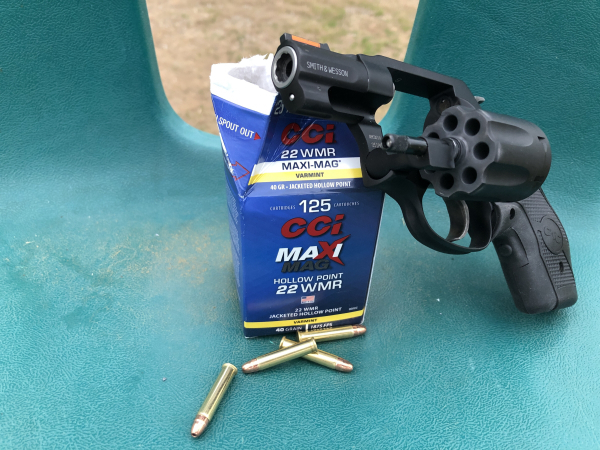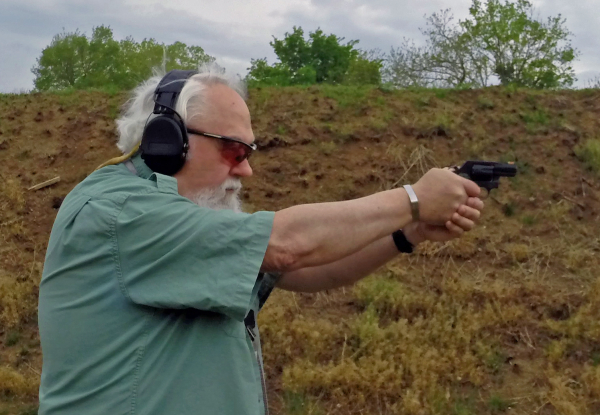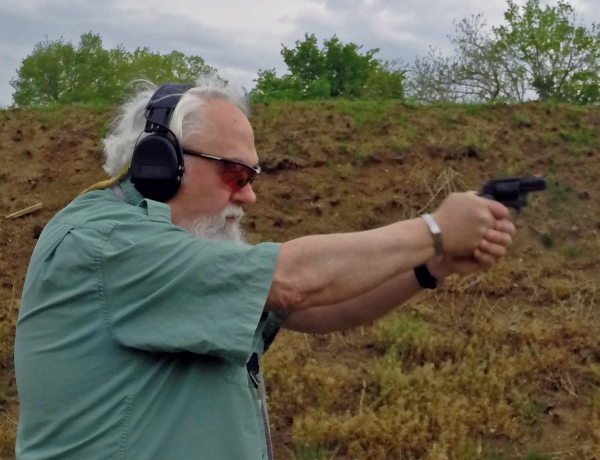
In a recent edition, I wrote about “wrong guns” in the context of an inexperienced person being led to believe small revolvers are not a good option for them. One of those ‘obviously true’ clichés, there can be exceptions. I believe that people need to learn their way about firearms generally. Hard-kicking, heavy trigger, lightweight revolvers ain’t easy – but they can be the best choice for a few jobs.
When it’s decided that’s it’s the micro-revolver that best fits the bill, then we have to examine ways to mitigate their negative aspects.
One problem is the ‘hard-kicking’ cartridge in the light gun; try to solve that by going to a sub-caliber, you have a pair of irritants that pop up. One is that most of those rounds in available revolvers are rimfire and require a lusty hammer fall to reliably ignite those rounds “most of the time.” That makes the tough trigger tougher. If you can build up grip and work through it, it’s worth your time. That increase in grip also shows dividends when you go to score the target.
Another asset is that it’s great trigger control practice. If you’re trying for precision while holding an only slightly more than 11 ounce revolver and it has heavy trigger, working through that pays dividends when the gun weighs a pound and a half and features a 4-pound trigger.
The other main problem arising from avoiding recoil by “going small” is the inevitable flood of outrage from ‘caliber commandos,’ those common taters (thanks, Claude) who will preach long and loud about ‘having enough gun.’ If the choice is “enough gun” or “no gun,” you’re out of choices. I’d relegate the caliber commandos to the irrelevancy. Until you can make adult decisions, you don’t get any notice.
Face it: while the lesser of two evils is still evil – if those are the only choices available, you’re wise to pick the one that sucks least.
As to making the gun as shootable as possible, revolvers have one advantage over ‘flat guns’ made of polymer. If the interface to your hand (the stock) causes discomfort, it slows you down, or you can’t keep it in place – you simply change it. If you can change it and use the new stock to help you quickly get on to target in the visual sense, it’s “more better.”
Currently, the chatter is about one or the other of the various 32 caliber cartridges. The sole issues working against that choice are issues of availability; of both firearms options and of ammunition. Ammo companies are currently running full-throttle trying to maintain a supply of commonly demanded rounds. The less in demand 32? It gets harder to find. More gun choices might help, but I though ammo companies would use the Mossberg Shockwave 20 gauge to develop the 20 shotshell the way .410 revolvers drove 410 ammo development.
It didn’t happen. So why should the big gun companies make runs of revolvers that would accept .32 S&W Long, .32 H&R Magnum and .327 Federal Mag?
When looking at true subcalibers, the 22 LR is bulk produced with a few of the high performing examples rising in price to near-centerfire levels. That leaves 22 MRF. While some will howl at the pitiful nature of the 22 Magnum, I remember reading that no less a gunman than Bill Jordan had, fifty years ago, considered it.
“The one light loading that I would like to see would be the airweight model Cobras and Chief Specials chambered for the new .22 RF Magnum load. This is a wicked little cartridge and would add little to the weight of the light models (five .38 Special cartridges weigh about as much as the Chief airweight), and would make a wonderful addition to the "hide-out" field, particularly for officers working in hot countries where usually a coat is not worn during the hot summer months.” (p.77) – and –
“A recent letter from Doug Hellstrom, Smith and Wesson's dynamic young executive vice-president, says that they are working on the problems attendant to marrying the .22 RF Magnum to the Chief airweight — and there are lots of problems. Aluminum cylinder and barrel with steel liners are indicated to keep down weight. The big problem, however, is devising a method to keep the hot gases from eating through the aluminum frame above the junction of cylinder and barrel. If this problem can be whipped it should result in the perfect hideout gun. It will not only outreach a switch blade, but will pack plenty of close range authority into an easily carried and concealed package.” (P.79) © 1965: Jordan, William H. "Bill," No Second Place Winner.
He was Assistant Chief Patrol Inspector of the U.S. Border Patrol, experienced lawman and game hunter. To say he’d participated in and seen a lot of action, including shootings of people and game would be an understatement. If he thought a snub .22 Magnum was a good idea, I’m not going to call it stupid.
As the manufacturing problems of the earlier time are resolved, let’s consider an 11 ounce, seven-shot .22 Rimfire Magnum revolver. Easily manipulated, easy to shoot without cumbersome recoil – there is some blast – but why would you want such a pint-sized self-defense firearm?
The premise for all this is self-defense when a larger gun likely won’t be carried. If you’re going someplace where carry of the firearm could cause consternation if it was discovered – could lose you your livelihood, get you ejected, keep you from being allowed entry with friends or family – and a smaller gun with which you have demonstrated competence will more likely be undetected. . . the lesser of two evils.
If you prefer being disarmed, go for it. Some of us won’t be buying in. After replacing the factory stocks on the S&W M351PD with Crimson Trace Lasergrips, I found I could get a quicker, repeatable hold on the gun. The projected laser dot wasn’t required, but I checked zero with it anyway on a reduced target while shooting two-handed from the hip.


Using the new ‘milk carton’ packaged CCI Mini-Mags, I sought to find out if the re-stocked micro-gun still shot to point of aim in my hands. It did. The stop-action photos from an action cam shows that there actually is recoil generated in the ca. 11 ounce revolver with 40 grain Maxi-Mags. It’s not the same character as 1100 fps 357 Magnum rounds out of the M&P340 (less than 14 ounces, empty). Nearly negligible, there’s still a little motion at ignition.
We’ll be examining carry methods with the M351PD and other small guns as we continue down the trail of ‘close concealment.’
- - Rich Grassi